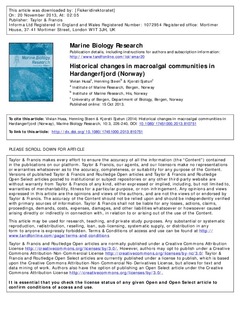Historical changes in macroalgal communities in Hardangerfjord (Norway)
Journal article, Peer reviewed
Permanent lenke
http://hdl.handle.net/11250/109096Utgivelsesdato
2013-10-15Metadata
Vis full innførselSamlinger
- Articles [3009]
Originalversjon
Vivian Husa, Henning Steen & Kjersti Sjøtun (2014) Historical changes in macroalgal communities in Hardangerfjord (Norway), Marine Biology Research, 10:3, 226-240, DOI: 10.1080/17451000.2013.810751 10.1080/17451000.2013.810751Sammendrag
Hardangerfjord is the second largest fjord in Norway and is situated on the southwest coast. During the last century the fjord has been influenced by a variety of anthropogenous activities such as industry, hydro-electrical power plants and since 1980 an increase in fish farming. This study was carried out in order to investigate whether changes in the macroalgal communities of Hardangerfjord have taken place since the 1950s. The macroalgal composition at a number of stations investigated in 2008–2009 was compared to recordings from the same stations during the 1950s. While the distribution and abundance of dominant groups (fucoids, kelps) showed a high resilience when compared to recordings from the 1950s, some changes in the macroalgal communities in the fjord were evident. The present study showed higher species richness and a higher frequency of species with a warm-water affinity. Since the first part of the 1990s an increase in summer sea surface temperatures has taken place in the area, and the observed algal changes suggest a pronounced temperature effect on macroalgal communities. A number of red algal species was observed to protrude further into the fjord in the present study than in the 1950s, probably caused by altered salinity regime due to the electrical power industry.
